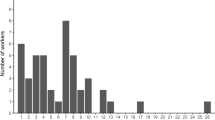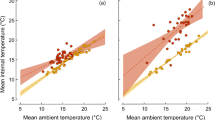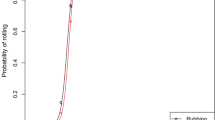Abstract
MANY animals restrict their foraging activities to certain times of the day or night, but the Saharan silver ant Cataglyphis bombycina is exceptional in that all foragers leave their underground nest in an explosive outburst confined to a few minutes per day during the hottest midday period. The foraging activity of this 'thermophilic' ant is compressed into a small thermal window by predatory pressure on the one hand and heat stress on the other.
This is a preview of subscription content, access via your institution
Access options
Subscribe to this journal
Receive 51 print issues and online access
$199.00 per year
only $3.90 per issue
Buy this article
- Purchase on Springer Link
- Instant access to full article PDF
Prices may be subject to local taxes which are calculated during checkout
Similar content being viewed by others
References
Larmuth, J. Sahara Desert (ed. Cloudsley-Thompson, J. L.) 57–66 (Pergamon, Oxford, 1984).
Coenen-Stass, D. Monit. Zool. Ital. (NS) Monogr. 4, 425–434 (1989).
Clark, W. H. & Comanor, P. L. Amer. Midl. Naturalist 90, 467–474 (1973).
Rogers, L. E. Environ. Entomol. 3, 420–424 (1974).
Schumacher, A. & Whitford, W. G. Insectes Sociaux 21, 317–330 (1974).
Briese, D. T. & MacAuley, B. J. Aust. J. Ecol. 5, 121–134 (1980).
Morton, S. R. Evolution of the Flora and Fauna of Arid Australia (ed. Barker, W. R. & Greenslade, P. J. M.) 257–262 (Peacock, Adelaide, 1982).
Marsh, A. C. J. arid Environ. 14, 61–73 (1988).
Curtis, B. A. J. Insect Physiol. 31, 463–466 (1985).
Marsh, A. C. Physiol. Zool. 58, 626–636 (1985).
Wehner, R., Harkness, R. D. & Schmid-Hempel, P. Foraging Strategies of Individually Searching Ants, Cataglyphis bicolor (Hymenoptera: Formicidae) (Fischer, Stuttgart, 1983).
Bakken, G. S. J. theor. Biol. 60, 337–384 (1976).
Casey, T. M. Insect Thermoregulation (ed. Heinrich, B.) 80–114 (Wiley, New York, 1981).
Hefetz, A. & Lloyd, H. A. Z. Naturforsch. C. 40, 665–666 (1985).
Salvador, A. Bonner Zool. Beitr. 16, 1–167 (1982).
Bons, J. Bull. Soc. Sci. Nat. Maroc 38, 167–182 (1959).
Blanc, C. P. & Sciortino, P. Bull. Soc. Sci. Nat. Tunisie 13, 25–38 (1978).
Nouira, S. Bull. Soc. Zool. France 108, 477–483 (1983).
Busack, S. D. Copeia 76, 826–830 (1976).
Pough, R. H. & Busack, S. D. J. therm. Biol. 3, 203–205 (1978).
Bradshaw, S. D. Ecophysiology of Desert Reptiles (Academic, Sydney, 1986).
Pianka, E. R. Ecology and Natural History of Desert Lizards (Princeton Univ. Press, New Jersey, 1986).
Author information
Authors and Affiliations
Rights and permissions
About this article
Cite this article
Wehner, R., Marsh, A. & Wehner, S. Desert ants on a thermal tightrope. Nature 357, 586–587 (1992). https://doi.org/10.1038/357586a0
Received:
Accepted:
Issue Date:
DOI: https://doi.org/10.1038/357586a0
Comments
By submitting a comment you agree to abide by our Terms and Community Guidelines. If you find something abusive or that does not comply with our terms or guidelines please flag it as inappropriate.



